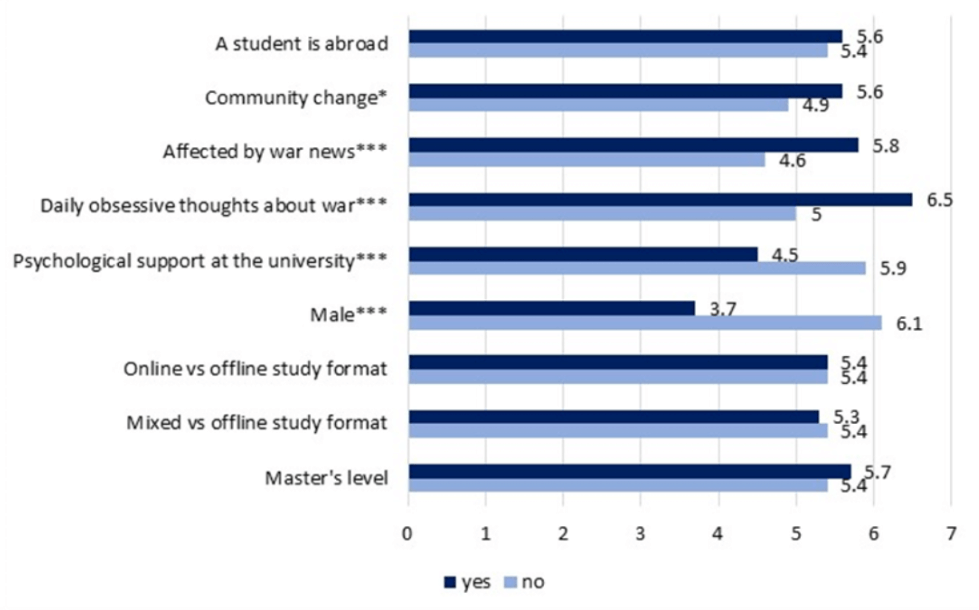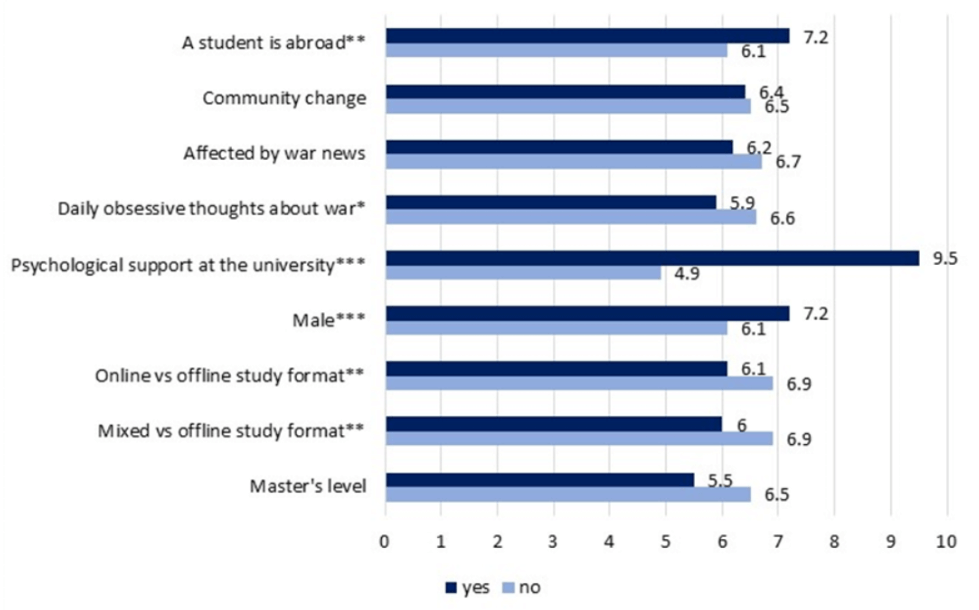This study examines the mental health of students from Kyiv universities in the context of 21 months of the full-scale war in Ukraine. Our primary dataset is derived from an online survey. We analyze two key facets of mental health: anxiety levels and safety perception. Our findings reveal that anxiety levels among students are primarily associated with the frequency of contemplation regarding the ongoing war and their emotional responses to war-related news. Expectedly, safety perception is higher for students studying abroad during the conflict. For students who remain in Ukraine, the absence of psychological support from the university and the shift to online/mixed study formats contribute to a lower sense of safety.
War exerts diverse effects on individuals, manifesting negative repercussions on mental health. This impact is particularly apparent among youth, notably students, who bear a double burden of stress. Young people not only struggle against the permanent threat of missile attacks but are also expected to persist in their educational pursuit. The dual demand places them in a challenging position as they endeavor to cope with the adversities of war while simultaneously laying the groundwork for their future careers and the collective skill reservoir of the nation. This study examines mental health within the student population in Kyiv during November 2023. The primary objective is to define which young individuals bear a greater impact of the ongoing war.
Previous investigations into the influence of military conflicts on mental well-being have established that war induces multifaceted effects on individuals. War is usually associated with the upheaval of daily routines, reallocation, disruption of social networks, and exposure to death that contribute to a spectrum of mental health challenges. Consequently, those directly exposed to the experience of war tend to exhibit elevated levels of anxiety, depression, stress, and symptoms related to trauma. Moreover, these repercussions tend to be more severe for individuals who were already predisposed to anxiety and depression or had even mild pre-existing mental health issues.
Recent studies concentrating on the impact of the first stage of Russian invasion of Ukraine (2014-2021) confirm these findings, demonstrating that individuals residing in conflict regions were more likely to show higher levels of depression, anxiety, or stress than the rest of the Ukrainian population. Furthermore, research suggests that these repercussions cannot be neutralized through displacement even to other countries. In fact, individuals who chose to stay in Ukraine exhibited notably lower levels of anxiety, depression, stress, and trauma-related symptoms in comparison to their counterparts who relocated abroad. However, this analysis did not take into account the potential inclination of individuals with heightened psychological sensitivity or trauma to migrate from the country during military conflicts.
Furthermore, scholars suggest that warfare introduces an additional adverse influence on young individuals by compelling a shift towards online learning as opposed to traditional offline modalities. Their findings primarily show that remote learning is less efficacious for students than face-to-face learning. The mental challenges arise from the fact that young individuals often struggle to adapt and communicate effectively in a social environment, while online forms of studies hinder the development of trusting interpersonal relationships with peers and educators.
This research seeks to analyze the current mental health status among students in Kyiv universities, taking into consideration both the direct impact of war through exposure to news and the indirect impact associated with the transition to online forms of study. Our analysis is unique because it is based on data from an online survey conducted and administered by the authors in November 2023. The sampling strategy relied on voluntary participation, offering interested students the opportunity to contribute. We recognize that there may be a selection bias in our sample, given that participants may be more self-aware of their mental health issues than non-participants. Overall, 184 students participated in this survey. The sampled individuals ranged in age from 18 to 25, with a mean age of 18.6 years. 70.3 percent of respondents were female, while 29.7 percent were male. Additionally, half of the respondents were students of the Kyiv School of Economics, reflecting the authors’ affiliation with this university and their facilitated access to the study population.
Mental health is assessed through anxiety levels and the perception of safety. Participants evaluate their anxiety levels and perceived safety by assigning a numerical value within the range of 1 to 10, where 10 is the largest anxiety and sense of safety respectively. We then compare (with the help of t-test) the mean values of anxiety and safety perception across different student groups. We present our findings in Figure 1 for anxiety and Figure 2 for safety perception. The t-test outcomes for the comparative analyses are summarized in Annex 1.
Figure 1: Variations in anxiety levels among students of Kyiv universities
Notes: *** p<0.01, ** p<0.05, * p<0.1. The graph illustrates the average anxiety levels across different categories of students. For example, the figure shows that the average anxiety level for students residing abroad (dark blue bar) is 5.6, whereas for those staying within the country (light blue bar), it is 5.4.
Overall, the respondents indicated an average level for both anxiety (5.4 out of 10) and safety perception (6.4 out of 10). Our analysis has not revealed any discernible distinction in anxiety levels between students currently residing abroad and those who have chosen to stay in Ukraine. Both groups of participants have indicated a similar level of anxiety, rating it at 5 out of 10. Contrary to prevailing research, our results show that those abroad do not demonstrate elevated anxiety levels, potentially reflecting the ease with which young individuals navigate new environments, framing the experience as positive rather than detrimental. Nevertheless, individuals residing abroad report a greater sense of safety compared to respondents within the country (6.3 vs 5.6).
Figure 2: Variations in safety perception among students of Kyiv universities
Notes: *** p<0.01, ** p<0.05, * p<0.1. The graph depicts average safety perception levels among various categories of students. For instance, students residing abroad report an average safety perception level of 7.2 (dark blue bar), while those staying within the country exhibit a safety perception level of 6.1 (light blue bar).
A comparable pattern emerges in the case of internal displacement. Students who changed their community after the outbreak of the war reported only slightly higher anxiety levels (5.6) compared to those who stayed in their original community (4.9) (the difference between them is marginally significant). The change of community did not affect safety levels among the young population, which again can be explained by the high adaptability of young people to new environments.
Exposure to war-related news significantly contributes to anxiety of students but does not strongly affect perceptions of safety. While the presentation of war in the news raises awareness of potential dangers, it does not appear to influence the perceived safety of young individuals directly. By contrast, young individuals who contemplate about war on a daily basis tend to exhibit elevated levels of anxiety (6.5 vs 5.0) and a diminished sense of safety (5.9 vs 6.6) compared to those who do so less frequently. This suggests that the internalization and persistent consideration of war-related thoughts may negatively impact the mental well-being of students.
No wonder that the mental health of Ukrainian students seems to be influenced by the availability of psychological support at their educational institutions. Students attending universities without such services indicate higher levels of anxiety (5.9) compared to their counterparts who have access to psychological support on campus (4.5). Similarly, individuals accessing psychological services at their place of study report safety perception scores that are twice as high (9.5) as those attending universities without such services (4.9).
The form of study does not seem to influence anxiety levels among students in Kyiv universities. However, the offline format appears to correlate with increased safety perception. In particular, the safety levels of students engaging in online or mixed-format studies hover around 6, whereas for offline students, they reach 6.9. At the same time the presence of shelters at the academic institution does not exhibit a statistically significant correlation with anxiety levels or safety perceptions. Thus we can infer that increased opportunities for socializing and participation offered by offline study mode foster a sense of belonging that may enhance the feeling of safety.
Finally, our results suggest that male students demonstrate lower anxiety levels (3.7 vs 6.1) and a heightened sense of safety (7.2 vs 6.1) compared to their female counterparts. This observation is consistent with existing research indicating that females tend to be more emotionally responsive and less resilient to stressors. It is noteworthy that this gender-related difference in mental health resilience among males persists even in the context of wartime, where there is a risk of conscription into the military for men after completion of their studies.
Policy implications
Our research findings suggest several policies to enhance the mental health of students during the ongoing war in Ukraine.
Firstly, we recommend that universities provide psychological support services to assist students in coping with the mental strain induced by war-related thoughts. Engaging with specialists to discuss obsessive thoughts about war can be therapeutic, aiding students in navigating challenging circumstances. Furthermore, integrating psychological services within universities may alter student perceptions, fostering a more positive attitude towards seeking psychological support. Establishment of such services at universities could contribute to minimizing the adverse mental health effects of the ongoing conflict on young individuals.
Secondly, we propose the provision of job-search support programs for students nearing graduation, addressing the uncertainty they face in securing employment during wartime. By offering targeted support, universities can mitigate the stress associated with job search in conflict conditions, thereby contributing to the preservation of the overall health and psychological well-being of the young population. Establishing placement offices for youth at universities can reduce uncertainty in accessing labor market opportunities and facilitate the retention of young, highly qualified individuals within the country.
Finally, we recommend developing tailored policies to address the distinct impact of war conditions on female students. Recognizing and responding to their heightened vulnerability to stress can support their resilience in the face of challenges and contribute to their overall well-being during the ongoing conflict. For instance, there can be trauma-informed counseling and support centers within or in close proximity to educational institutions in conflict zones, exclusively for female students. In addition, universities can employ counselors to understand and address the unique psychological and emotional challenges that female students may experience during wartime.
The proposed policies may create a supportive environment for students, acknowledging the diverse challenges they face during wartime. By addressing mental health needs through targeted interventions, universities can play a crucial role in fostering the well-being and resilience of the young population in Ukraine.
Annex 1. A t-test of differences in mean values by group
| Mean values | Diff | p-value for the t-test | |
| Anxiety | |||
| Abroad (1= Yes) | 5.6 | 0.2 | 0.773 |
| (0= No) | 5.4 | ||
| Community change (1= Yes) | 5.6 | 0.7* | 0.065 |
| (0= No) | 4.9 | ||
| Affected by war news (1= Yes) | 5.8 | 1.2*** | 0.001 |
| (0 = No) | 4.6 | ||
| Frequency of obsessive thoughts about war
(1 = On a daily basis) |
6.5 | 1.5*** | 0.000 |
| (0 = Less frequently) | 5.0 | ||
| Psychological support at the university
(1 = Yes) |
4.5 | – 1.4*** | 0.005 |
| (0 = No) | 5.9 | ||
| Study format | |||
| Online | 5.4 | 0.0 | 0.978 |
| Mixed | 5.3 | – 0.1 | 0.994 |
| Offline | 5.4 | Reference | |
| Year of Study (1 = Master) | 5.7 | 0.3 | 0.667 |
| (0 = Bachelor) | 5.4 | ||
| Gender (1 = Male) | 3.7 | – 2.4*** | 0.000 |
| (0 = Female) | 6.1 | ||
| Safety perception | |||
| Abroad (1= Yes) | 6.3 | 0.7** | 0.015 |
| (0= No) | 5.6 | ||
| Community change (1= Yes) | 6.4 | – 0.1 | 0.773 |
| (0= No) | 6.5 | ||
| Affected by war news (1= Yes) | 6.2 | – 0.5 | 0.187 |
| (0 = No) | 6.7 | ||
| Frequency of obsessive thoughts about war
(1 = On a daily basis) |
5.9 | – 0.7* | 0.068 |
| (0 = Less frequently) | 6.6 | ||
| Psychological support at the university
(1 = Yes) |
9.5 | 4.6*** | 0.000 |
| (0 = No) | 4.9 | ||
| Study format | |||
| Online | 6.1 | – 0.8** | 0.034 |
| Mixed | 6.0 | – 0.9** | 0.025 |
| Offline | 6.9 | Reference | |
| Year of Study (1 = Master) | 5.5 | – 1.0 | 0.327 |
| (0 = Bachelor) | 6.5 | ||
| Gender (1 = Male) | 7.2 | 1.1*** | 0.001 |
| (0 = Female) | 6.1 | ||
Notes: *** p<0.01, ** p<0.05, * p<0.1.
Attention
The authors do not work for, consult to, own shares in or receive funding from any company or organization that would benefit from this article, and have no relevant affiliations





